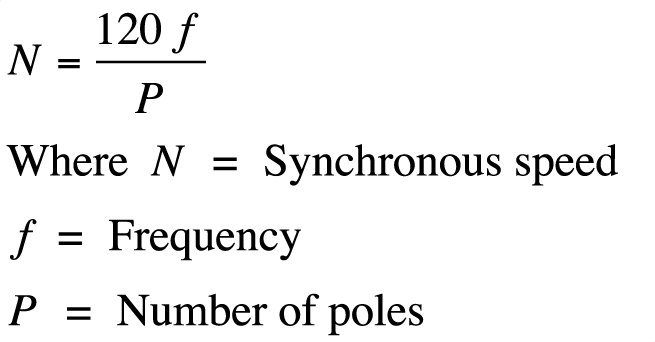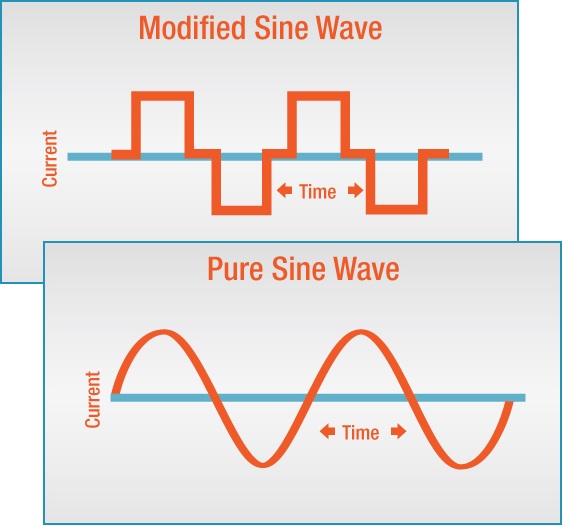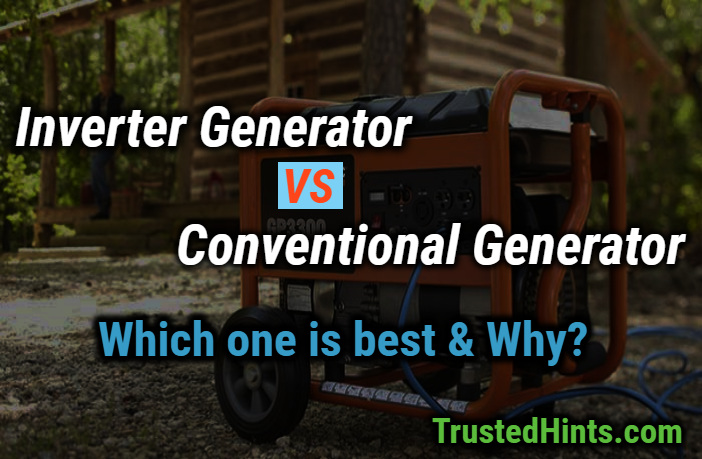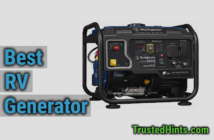If you are new in the generator market, then it can become very cumbersome to understand the differences between different generators. In this post, I will cover the difference between the inverter generator and the conventional generator and which is superior.
What is the difference between inverter generator and generator?
One of the biggest differences between an inverter generator and a generator is that; the conventional generator directly produces the AC power whereas the inverter generator, first of all, produces AC power then converts into DC power and then again converts back to AC power (this procedure has a lot of advantages which we will discuss in detail below).
Fuel Efficiency
To understand how both generators differ in terms of fuel efficiency, let’s understand this equation of speed.
Don’t worry I will try to keep things as simple as possible, so just bear with me.

The speed of the generator is given through the above equation. It means at what speed the generator must run to produce the required power output.
Now the poles of the generator are coils which are wound together to induce the voltage in it and all the household generator have 2 poles.
Many countries like the USA and CANADA use the 60Hz power supply and if this frequency fluctuates even the slightest (for example if this value fluctuates to even 59.5Hz or 60.5Hz) then it will damage your electric appliances. So that is why the frequency of supplied power must be 60Hz.
Now the number of poles is fixed (which is 2), so in order to get the 60Hz of power supply, the generator must run at a constant 3600 RPM (rotation per minute).
The non-inverter generator produces direct AC power so no matter what your load requirements are the non-inverter generator will consume the same amount of fuel.
Didn’t understand? Well, let’s understand it by this example. The non-inverter generator can produce a maximum of 4000 watts of power but at the time being, you need only 2000 watts. So no matter if you need 4000-watts or 2000-watts, the generator must run at 3600 rpm speed (to produce 60Hz supply). So in both cases, the generator will consume the same amount of fuel and that is why they are not fuel-efficient as inverter generators.
Now let’s understand why the inverter generator is so fuel-efficient. As I said earlier the inverter generator, first of all, produces AC power and then converts it to DC and then again converts back to AC.
So now there is no need for the generator to run at 3600 RPM because even if it rotates at let’s say 1500 RPM speed and produces 25 Hz of AC power supply, the rectifier circuitry of this generator will convert this AC power to DC, and then the inverter circuitry will convert this DC power to 120-volt 60Hz AC supply.
So what I am saying is, the inverter generator adjusts the speed of the rotor according to load requirements and thus consumes less fuel.
Conclusion: So unless you are running your inverter generator at maximum load capacity (at maximum load capacity it will run at maximum speed) it will consume less fuel compared to the non-inverter generator so you will be able to save a lot of money on fuel in the long run.
If you are looking for an inverter generator then check out the Reviews of Inverter Generator.
Read Also,
- Best Dual Fuel Generator Reviews
- Best Solar Generator
- Difference Between Propane Generator And Gas Generator
Noise
Noise is one of the most important factors when you purchase the generator because no one likes the noisy generator.
To understand this portion of the comparison you first must understand the above portion, after that it will be very easy for you to under this.
A Generator makes noise mainly due to fuel combustion in the engine and rotation of its mechanical parts and gears.
The inverter generator only runs at full speed (i.e 3600 RPM) when you need maximum watts of power output from the generator. So at that time, the noise output of the generator will also be maximum and this applies to non-inverter or conventional generator too.
But as the power demand from the inverter generator decreases, the noise output will also decrease but this will not happen in conventional generators because it will always run at 3600 RPM speed.
Moreover, the inverter generators are equipped with special mufflers and sound dampening technology which in turn reduces the noise further but on the other hand, they are expensive too. But trust me, cost-saving on fuel and the noise-free atmosphere is worth every penny you spend on the inverter generator.
Maximum Power Output
The inverting and rectifying circuit of the inverter generator cannot handle high power and that is why they don’t come with high-power capacity.
The maximum power capacity inverter generator we have seen is the Champion 6250-Watt inverter generator.
However, some of the high-capacity inverter generators come with parallel capability so you can get higher power output by connecting two inverter generators in parallel. Please note that the Champion 6250-Watt inverter generator does not come with parallel capability.
The non-inverter generator, on the other hand, comes with power output up to 18000 watts. But if you need only up to 6000 running watts, then you can choose the inverter generator.
Quality of Produced Power

The quality of power is usually measured by its THD (third harmonic distortion). The high THD indicates the low quality of power. Any non-inverter generator has less than 10% THD whereas a typical inverter generator has less than 3% THD.
A conventional or non-inverter generator runs at 3600 RPM to produce the desired frequency and it generates direct AC power without any processing. As a result, the output power is not a sine wave but instead, it is a modified sine wave.
In the case of the inverter generator, the power is produced in the form of a modified sine wave and then with the help of a rectifier, it is converted to DC power. Now this DC power is converted back to AC power and the inverter circuit is equipped with capacitors which removes the harmonics from power.
As a result, you will get steady and clean AC power. This clean power is very essential when running sensitive devices like phones, computers, printers, DVD players, and TVs.
These sensitive devices use microprocessors which can easily be affected by the quality of power. The inverter generator has the upper hand here.
Price
All the non-inverter generator come with many features such as dual-fuel capability, RV-ready, electric start, and Parallel capability; thus, they have the same price as the inverter generator.
For example, the Champion 3800-Watt Dual Fuel portable generator costs about 570 dollars and the Champion 4000-Watt inverter generator costs about 600 dollars.
The inverter generator does not offer features like dual-fuel capability hence it is cheaper. There is a dual-fuel inverter generator available too but it is very costly.
So my point is there are all types of generators available which vary in features and price. So, in the end, it depends on you that what type of generator you want and what features you need. Based on this you have to select the generator.
So if you are looking for any specific generator and can’t figure out which one to choose then comment down below and we will try to help you the best we can.
Read More: How to Connect a Portable Generator to Electrical Panel?
Wrapping it up.
Now that you know the difference between both the generators, it will help you make a better buying decision. In our opinion, you should opt-in for an inverter generator that has higher fuel-efficiency, compact design, much quieter operation, and clean power output. If you need high power output such as 12,000 watts, then you should choose a non-inverter generator such as a camping generator, solar generator, or home generator.




